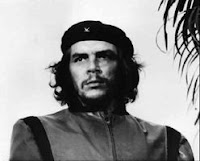 About this time last year (March 2006) Communication Arts magazine ran a cover story about graphic design in Cuba that featured a two-color interpretation of Alberto "Korda" Gutierrez's iconic image of Argentine Marxist revolutionary Che Guevara by modern Cuban graphic artist Edel Rodriguez.
About this time last year (March 2006) Communication Arts magazine ran a cover story about graphic design in Cuba that featured a two-color interpretation of Alberto "Korda" Gutierrez's iconic image of Argentine Marxist revolutionary Che Guevara by modern Cuban graphic artist Edel Rodriguez.The original image was taken by Cuban photographer Korda at a memorial service for the victims of the 4 March 1960 explosion of the Belgian arms transport "La Coubre" in Havana harbor – a disaster that cost the loves of approximately 136 people. Korda was a staff photographer for the Cuban newspaper Revolution, and used a Leica camera to photograph two frames of Che as he appeared briefly on stage during a lengthy speech by Fidel Castro.
 The original photograph is a 6x10 inch silver-gelatin print entitled Guerrillero heroico (Heroic Guerrilla). Korda's image of Che has become one of the most reproduced and recognizable images of the 20th century – called by some "the most famous photograph in the world and a symbol of the 20th century". And Korda, for his part, was not opposed to such reproduction s long as it served appropriately revolutionary purposes. On this point, he is quotes as having said, "As a supporter of the ideals for which Che Guevara died, I am not averse to its reproduction by those who wish to propagate his memory and the cause of social justice throughout the world, but I am categorically against the exploitation of Che's image for the promotion of products such as alcohol, or for any purpose that denigrates the reputation of Che."
The original photograph is a 6x10 inch silver-gelatin print entitled Guerrillero heroico (Heroic Guerrilla). Korda's image of Che has become one of the most reproduced and recognizable images of the 20th century – called by some "the most famous photograph in the world and a symbol of the 20th century". And Korda, for his part, was not opposed to such reproduction s long as it served appropriately revolutionary purposes. On this point, he is quotes as having said, "As a supporter of the ideals for which Che Guevara died, I am not averse to its reproduction by those who wish to propagate his memory and the cause of social justice throughout the world, but I am categorically against the exploitation of Che's image for the promotion of products such as alcohol, or for any purpose that denigrates the reputation of Che."Thus enter Edel Rodriguez's new composition of Che, featuring the Nike swoosh on his beret and iPod ear buds snaking down his neck.
Like Korda, Rodriguez is a Cuban-born artist. And as he grew up in revolutionary Cuba, he became intimately familair with Korda's iconic image, drawing the famous image of Che about hundreds of time starting around age 3. Of this habit, Rodriguez writes, "It’s everywhere, so it’s what I drew, along with tanks, guns, and missiles, cause that’s what was on T.V. there. American kids draw superheroes and cartoons instead. Che was my Mickey Mouse."
Now, living in the U.S. and benefiting from a successful career in design, Rodriguez's interpretation of Korda's photograph brings the story of Che (and his likeness) full circle.
Rodriguez writes of his inspiration for the new design, "My family that is still in Cuba just got access to the internet, e-mail, etc. They are just learning about these i-pods, tech gear, brands, etc. So I’ve started gettting e-mails from them requesting things like memory sticks, i-pods, things with brand names, etc. Years ago I would get letters from them asking for medicine or food. So, the idea that Cuba is slowly changing into a capitalist society is what came of this communication with my family back on the island. And this image was the result.
"Another thing that has bugged me over the years is all these people with Che t-shirts and the whole Che cult. People that have no clue what a cold blooded killer Che was and how many people’s lives were ruined by the Cuban revolution (Not well to do folks, but artists, musicians, poets, homosexuals, or anyone that had individual ideas and expressed them.)
"So, people here in the U.S. that are all underground and hipster and “original” with the Che gear and that all wear the same brands and listen to their iPods annoy me. They try to act all rebel and counterculture but they’re all fitting in in their own way. I think this image worked for me as a criticism of such an attitude as well. I am very well aware that doing anything with 'Che' is the biggest cli-'Che' ever."
But we loved it – the masterful irony of a Marxist icon transformed (not my Rodriguez, but, as he notes, by modern pop-art consumers) into a capitalist mascot. Would the revolutionary roll over in his Bolivian grave if he knew what his legacy was fast becoming? Perhaps. Regardless, we felt the story of this image, and the artists behind it, spoke volumes. fb
